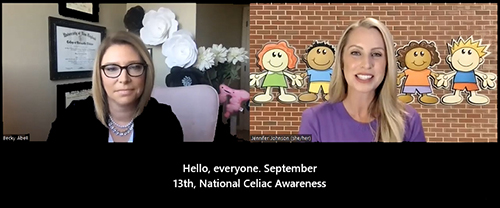Celiac Disease in Children
“Celiac Awareness Day with Dr. Becky Abell”
Jennifer Johnson, Director of Family and Community Outreach at GCH sat down virtually with Dr. Becky Abell to discuss all things Celiac in honor of "National Celiac Awareness Day!"
University of Rochester Medical Center, Department of Pediatrics, Gastroenterology, Hepatology and Nutrition Division
What is celiac disease?
Celiac disease is a digestive problem that hurts your small intestine. It stops your body from taking in nutrients from food.
People with celiac disease are sensitive to gluten. Gluten is a kind of protein found in wheat, rye, barley, and sometimes in small amounts in mixed oats.
When you have celiac disease and you eat foods with gluten, your body has a reaction that is not normal. The part of your body that fights disease (the immune system) starts to hurt your small intestine. It attacks the tiny bumps (villi) that line your small intestine. The villi help your body take in nutrients from food into your bloodstream. Without the villi, your small intestine can’t get enough nutrients, no matter how much food you eat.
Celiac disease is genetic. This means it can be passed down from parent to child.
More than 2 million Americans have been diagnosed with celiac disease. Studies show that as many as 1 in every 133 Americans may have it. They may not know they have it.
Celiac disease is more common in people:
- Whose ancestors came from Europe
- Who are white
- Who have type 1 diabetes
- Who have Down syndrome
- Who have other autoimmune diseases
- Who have irritable bowel syndrome with diarrhea
What causes celiac disease?
Celiac disease is a genetic disease that runs in families. You may have celiac disease and not know it because you don’t have any symptoms.
Some things that may make symptoms start to appear are:
- Too much stress
- Pregnancy or childbirth
- Surgery
- Physical injury
- Infection
What are the symptoms of celiac disease?
Celiac disease affects people in different ways. Some have symptoms as children. Others have symptoms only as adults. Some people have diarrhea and belly (abdominal) pain. Others may feel moody or depressed.
Each person’s symptoms may vary. Signs of celiac disease in children may include:
- Chronic diarrhea or (more rarely) constipation
- Pale, bad-smelling stool
- Vomiting
- Bloating and gas
- Irritability
- Decreased appetite and/or poor weight gain and/or weight loss
- Growth and pubertal delay
- Iron deficiency anemia
- Fatigue
- Fractures or thin bones
- Decreased muscle mass in the limbs
- Damage to tooth enamel or failure of enamel formation
- A chronic itchy rash called dermatitis herpetiformis, which can be painful.
- Stomach pain or swelling (bloating) that keeps coming back
- Joint pain, muscle cramps or bone pain
It is possible that you could have no symptoms from celiac disease. That is because the part of your small intestine that is not hurt can still take in enough nutrients. But you may still be at risk for problems of the disease.
How is celiac disease diagnosed?
Celiac disease can be hard to diagnose. Its symptoms may look like symptoms of other digestive problems such as:
- Crohn's disease
- Irritable bowel syndrome
- Ulcerative colitis
- Intestinal infections
- Small intestinal bacterial overgrowth
- Malabsorption
To see if you have celiac disease, your healthcare provider will look at your past health and do a physical exam. You may also have tests such as:
- Blood work. This is done to check the level of infection-fighting cells (antibodies) you have to gluten in your blood. People with celiac disease have higher than normal levels of these cells. Your immune system makes these cells to help fight things (such as gluten) that the body feels are a danger. A typical screening test includes anti-tissue transglutaminase (tTG) IgA and total serum IgA.
- Biopsy. This is the most accurate way to tell if you have celiac disease. Several tissue samples are taken from the first part of the small intestine to check for damage to the villi. To do this, a long, thin tube (endoscope) is placed in your mouth, down to your stomach and into your small intestine. The tissue samples are then taken using tools passed through the endoscope. The samples are then reviewed by a pathologist under the microscope. For more information about this procedure, see Upper Endoscopy.
What is the treatment for celiac disease?
If you have celiac disease, you must stop eating gluten. Eating gluten will do more damage to your small intestine. Eliminating gluten is the only treatment for this disease. You must not eat gluten for the rest of your life.
In most cases, taking gluten out of your diet will stop your symptoms. And, any damage to your intestine will heal. It will also stop any more damage from happening.
Removing gluten from your diet can be difficult. This is because gluten can contaminate many foods. It can be found in condiments, salad dressings, and other unexpected places. For this reason, your healthcare provider may refer you to a dietitian who specializes in celiac disease.
After you stop eating foods with gluten, your symptoms will likely get better in a few days. Your small intestine should heal completely in 3 to 6 months. Your villi will be back and working again. If you are older, it may take up to 2 years for your body to heal.
